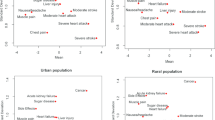Abstract
Objective: To determine whether physician willingness to prescribe drugs for primary prevention of cardiovascular disease is influenced by information about the resultant life-expectancy gains (presented in one of two formats) and about drug costs.
Materials and methods: Mailed survey (four versions randomly allocated) asking physicians to assess hypothetical preventive interventions with outcomes expressed either as averaged or as stratified gains in life expectancy (e.g., average gain of 15 weeks, versus 5% of treated patients gain 2 to 6 years, 10% gain up to 2 years, and 85% remain unchanged). Both costs and gains were varied to high and low values. The subjects rated their willingness to prescribe treatments on an 11-point scale from “strongly oppose” to “strongly favor.”
Participants: Internists randomly selected from two Canadian academic centers (n=330).
Results: 231 usable responses were received (76% of the deliverable questionnaires). For low-yield scenarios typical of very effective primary prevention strategies, the physicians gave significantly higher ratings in response to stratified life-expectancy data than to equivalent averaged data (p<0.0001). The same trend was not observed for high-yield scenarios (p=NS). The ratings were strongly influenced by cost: 34% of the physicians reversed their treatment decisions in response to a tenfold price increase. Despite this, the rankings of the treatments differed from those expected on the basis of cost-effectiveness criteria (p<0.0001).
Conclusions: Physician enthusiasm for a therapy designed to prolong life expectancy may be influenced by the format in which that life-expectancy gain is presented. Knowledge of drug cost also affects physicians’ choices, but their greater focus on treatment effects causes their rankings to depart from those expected with cost-effectiveness criteria.
Similar content being viewed by others
References
Tversky A, Kahneman D. The framing of decision and the psychology of choice. Science. 1981;211:453–8.
McNeil BJ, Pauker SG, Sox HC Jr, Tversky A. On the elicitation of preferences for alternative therapies. N Engl J Med. 1982;306:1259–62.
Forrow L, Taylor WC, Arnold RM. Absolutely relative: how research results are summarized can affect treatment decisions. Am J Med. 1992;92:121–4.
Naylor CD, Chen E, Strauss B. Measured enthusiasm: does the method of reporting trial results alter perceptions of therapeutic effectiveness? Ann Intern Med. 1992;117:916–21.
Redelmeier D, Tversky A. Discrepancy between decisions for individual patients and groups. N Engl J Med. 1990;322:1162–4.
Grover SA, Abrahamowicz M. Joseph L, Brewer C, Coupal L, Suissa S. The benefits of treating hyperlipidemia to prevent coronary heart disease. Estimating changes in life expectancy and morbidity. JAMA. 1992;267:816–22.
Poses RM, McClish D, Bekes C, Scott WE, Morley JN. Ego bias, reverse ego bias, and physicians’ prognostic. Crit Care Med. 1991;19:1533–9.
Davey Smith G, Song F, Sheldon TA. Cholesterol lowering and mortality: the importance of considering initial level of risk. BMJ. 1993;306:1367–73.
Frick MH, Elo O, Haapa K, et al. Helsinki Heart Study: primary-prevention trial with gemfibrozil in middle-aged men with dyslipidemia. N Engl J Med. 1987;317:1237–45.
Ontario Ministry of Health. Drug Benefit Formulary/Comparative Drug Index. Toronto, ON: Publications Ontario, 1992.
Canadian Medical Directory. Don Mills, ON: Southam Business Communications Inc., 1991.
Cohen J. Statistical Power Analysis for the Behavioral Sciences (rev ed). New York: Academic Press, 1977.
Taylor WC, Pass TM, Shepard DS, Komaroff L. Cholesterol reduction and life expectancy: a model incorporating multiple risk factors. Ann Intern Med. 1987;106:605-l4.
Weinstein ND. Optimistic Biases about Personal Risks. Science. 1989;246:1232.
Kahneman D, Slovic P, Tversky A (eds). Judgement under Uncertainty: Heuristics and Biases. New York: Cambridge, 1982.
McNeil BJ, Weichselbaum R, Pauker SG. Fallacy of the five-year survival in lung cancer. N Engl J Med. 1978;299:1397–401.
Safavi KT, Hayward RA. Choosing between apples and apples: physicians’ choices of prescription drugs that have similar side effects and efficacies. J Gen Intern Med. 1992;7:32–7.
Frazier LM, Brown JT, Divine GW, et al. Can physician education lower the cost of prescription drugs? A prospective, controlled trial. Ann Intern Med. 1991;115:116–21.
Author information
Authors and Affiliations
Additional information
Dr. Naylor receives salary support from Career Scientist Award 02377 of the Ontario Ministry of Health and from the Institute for Clinical Evaluative Sciences in Ontario.
Rights and permissions
About this article
Cite this article
Hux, J.E., Levinton, C.M. & Naylor, C.D. Prescribing propensity. J Gen Intern Med 9, 195–201 (1994). https://doi.org/10.1007/BF02600123
Issue Date:
DOI: https://doi.org/10.1007/BF02600123




